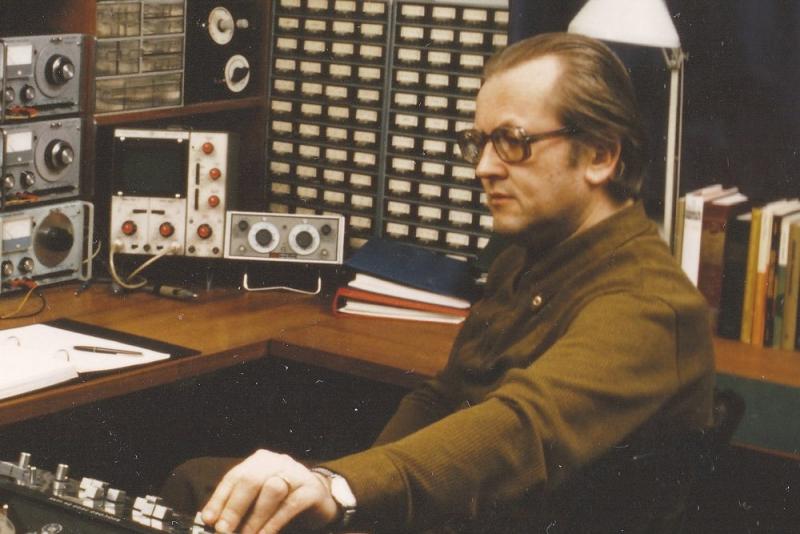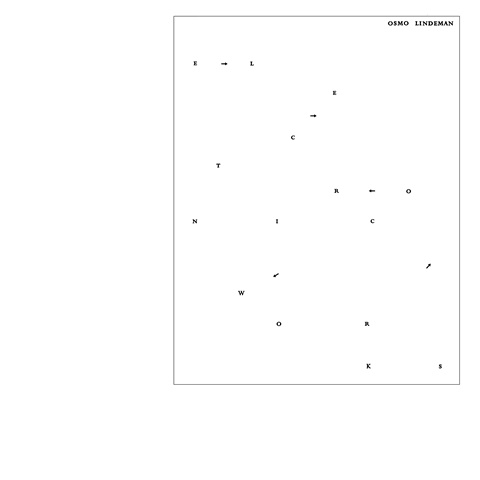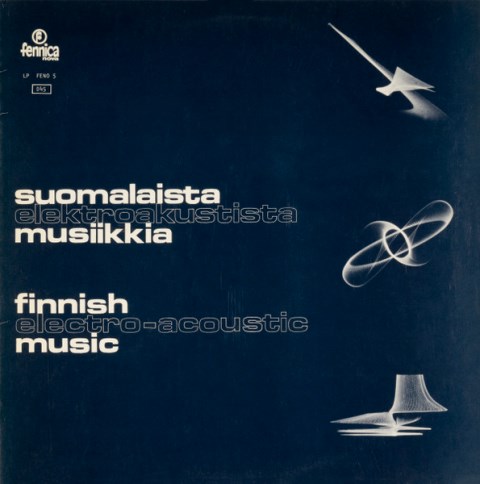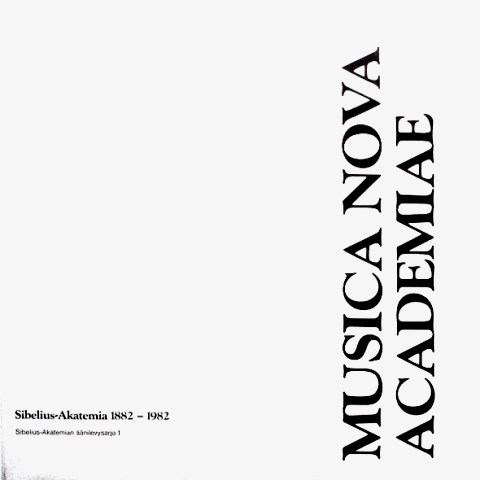Music Reissues Weekly: Osmo Lindeman - Electronic Works | reviews, news & interviews
Music Reissues Weekly: Osmo Lindeman - Electronic Works
Music Reissues Weekly: Osmo Lindeman - Electronic Works
Tribute to the Finnish composer and musician who embraced electronic music

For Finnish composer Osmo Lindeman, the decision to pursue electronic music was made in 1968 during a visit to Poland. He had recently started using graphical notation for the scores of his compositions and was having problems getting conductors and orchestras to follow what he wanted.
In Poland, he met composer Andrzej Dobrowolski and visited the Warsaw School of Music’s electronic music studio. He found that Dobrowolski also used graphical notation. With electronic music, Lindeman saw that there no barriers to using any type of score. He had the way forward. He would embrace electronic music.
 The route which took him to this point was curious. Osmo Uolevi Lindeman (1929–1987) had been in the Stig Wennström Dixieland Jazz Band, with whom he was the pianist on a couple of 78s issued in 1948 and 1949. Under his own name, a rumba-styled single titled “Latinalaisamerikkalaista” was issued in 1956. Around this time, he was also studying at Helsinki’s Sibelius Academy, which awarded him his composition diploma in 1959. The same year, helped by a UNESCO grant, he completed Inornata, his first symphony. Then, it was off to Munich’s State Institute of Music to study with Carl Orff.
The route which took him to this point was curious. Osmo Uolevi Lindeman (1929–1987) had been in the Stig Wennström Dixieland Jazz Band, with whom he was the pianist on a couple of 78s issued in 1948 and 1949. Under his own name, a rumba-styled single titled “Latinalaisamerikkalaista” was issued in 1956. Around this time, he was also studying at Helsinki’s Sibelius Academy, which awarded him his composition diploma in 1959. The same year, helped by a UNESCO grant, he completed Inornata, his first symphony. Then, it was off to Munich’s State Institute of Music to study with Carl Orff.
So far, so suggestive of a path from popular to classical music. Yet in 1959, he had composed the music for the Matti Kassila film Punainen viiva (Red Line). He then wrote the music for another Kassila movie, 1961’s Komisario Palmun erehdys (Gas, Inspector Palmu). For both, he received a Jussi award for best music for a film. Between 1959 and 1962, he worked on 10 films. He also composed music for TV. In 1962, he began lecturing in music theory at the Sibelius Academy. The popular and the classical were balanced with each other. In time, though, Lindeman – who was exploring tape manipulation – headed into the new territory of electronic music. He wasn’t alone in Finland. In the world of rock, Pekka Airaksinen was using tape manipulation in 1968, and the freaky band Electric Quartet employed a specially built four-player electronic instrument in 1970.
The double album Electronic Works picks up Lindeman’s story in 1967, with a ten-minute composition titled “Variabile” which was premièred on 7 December at a concert celebrating the 50th-anniversary of the Suomen Säveltaiteilijain liitto (The Finnish Composers’ Union). Under conductor Jorma Panula, The Helsinki Philharmonic performed “Variabile” at the University of Helsinki. Orchestral rather than electronic, it feels like a merging of Pierre Boulez and Stravinsky.
 Next up in the collection’s timeline are three pieces from 1969 – “Kinetic Forms,” “Mechanical Music for Stereophonic Tape” and “Is This the World of Teddy” (composed for a short of film of that name). These are electronic. Following the pivotal visit to Poland, in early 1969 Lindeman was given a programmable sequencer by its maker Erkki Kurenniemi. Each of these three pieces feature cascades of rhythmic notes generated by the eight-octave oscillator tied-in with the sequencer. They are more about form and texture than melody. Lindeman’s electronic period had begun. All the while, he lectured at the Sibelius Academy.
Next up in the collection’s timeline are three pieces from 1969 – “Kinetic Forms,” “Mechanical Music for Stereophonic Tape” and “Is This the World of Teddy” (composed for a short of film of that name). These are electronic. Following the pivotal visit to Poland, in early 1969 Lindeman was given a programmable sequencer by its maker Erkki Kurenniemi. Each of these three pieces feature cascades of rhythmic notes generated by the eight-octave oscillator tied-in with the sequencer. They are more about form and texture than melody. Lindeman’s electronic period had begun. All the while, he lectured at the Sibelius Academy.
Lindeman fashioned a home studio. He liked this as he could work when and how he pleased, without having to change from his dressing gown. He had an EMS VCS3 synthesiser, a Minimoog, oscillators and sound processers. He is quoted in the album’s liner notes as explaining in 1978 that he had “two different types of electronic sound synthesis equipment: a programmable digital sequence oscillator, and a group of different devices for signal generation, control and modification (oscillators, filters, modulators, echo units, mixers and metering equipment) and three stereo tape recorders.”
With his DIY set-up, he made music for himself and for television – two pieces for ads are heard on Electronic Works, as well as a theme for the national television news. The album ends with two longer compositons: 1972’s “Ritual” and 1974’s “Spectacle.” These were his only electronic works issued on record before this album.
 “Ritual” integrates chanting voices with the electronics. Its repetitive intensity and interjections of shattering sounds would not have been out of place in a horror film. When it was released on the very rare Suomalaista elektroakustista musiikkia: Finnish electro-acoustic music album in 1978 (pictured above left). The text on its sleeve said ““Ritual’ depicts a religious event which one may understand from any religious point of view. Dominating the opening part of the work is a monotonous and litany-like speaking – a kind of mumbling suggestive of an audience, or in this case congregation. An electronic backcloth, later rising into foreground, pictures the moods and emotional reactions of the easily impressionable congregation.”
“Ritual” integrates chanting voices with the electronics. Its repetitive intensity and interjections of shattering sounds would not have been out of place in a horror film. When it was released on the very rare Suomalaista elektroakustista musiikkia: Finnish electro-acoustic music album in 1978 (pictured above left). The text on its sleeve said ““Ritual’ depicts a religious event which one may understand from any religious point of view. Dominating the opening part of the work is a monotonous and litany-like speaking – a kind of mumbling suggestive of an audience, or in this case congregation. An electronic backcloth, later rising into foreground, pictures the moods and emotional reactions of the easily impressionable congregation.”
“Spectacle” is a three-part work employing the VCS3 and a Minimoog. It is spacey, its aural imagery suggesting the desiccated landscape of a planet with no atmosphere. It was first issued on the also very rare Musica Nova Academiae: Sibelius-Akatemia 1882–1982 album in 1982 (pictured above right). It was Lindeman’s last composition.
Although Lindeman began teaching electronic music at the Sibelius Academy in 1972, studied electronic music in the US in 1976 and 1977 and in 1980 published Elektroninen musiikki, Finland’s first text book on electronic music, the liner notes do not say why he ceased composing and recording in 1974, within this period. Mystery remains. Even so, the eye-opening Electronic Works is a fine tribute to a determined composer and musician whose profile needs boosting.
- Next week: When The Alarm Clock Rings – double-album “Compendium Of British Psychedelia 1966-1969”
- More reissue reviews on theartsdesk
- Kieron Tyler’s website
Share this article
The future of Arts Journalism
You can stop theartsdesk.com closing!
We urgently need financing to survive. Our fundraising drive has thus far raised £49,000 but we need to reach £100,000 or we will be forced to close. Please contribute here: https://gofund.me/c3f6033d
And if you can forward this information to anyone who might assist, we’d be grateful.

Subscribe to theartsdesk.com
Thank you for continuing to read our work on theartsdesk.com. For unlimited access to every article in its entirety, including our archive of more than 15,000 pieces, we're asking for £5 per month or £40 per year. We feel it's a very good deal, and hope you do too.
To take a subscription now simply click here.
And if you're looking for that extra gift for a friend or family member, why not treat them to a theartsdesk.com gift subscription?
more New music
 Music Reissues Weekly: Joe Meek - A Curious Mind
How the maverick Sixties producer’s preoccupations influenced his creations
Music Reissues Weekly: Joe Meek - A Curious Mind
How the maverick Sixties producer’s preoccupations influenced his creations
 Pop Will Eat Itself, O2 Institute, Birmingham review - Poppies are back on patrol
PWEI hit home turf and blow the place up
Pop Will Eat Itself, O2 Institute, Birmingham review - Poppies are back on patrol
PWEI hit home turf and blow the place up
 'Fevereaten' sees gothic punk-metallers Witch Fever revel in atmospheric paganist raging
Second album from heavy-riffing quartet expands sonically on their debut
'Fevereaten' sees gothic punk-metallers Witch Fever revel in atmospheric paganist raging
Second album from heavy-riffing quartet expands sonically on their debut
 theartsdesk Q&A: Soft Cell
Upon the untimely passing of Dave Ball we revisit our September 2018 Soft Cell interview
theartsdesk Q&A: Soft Cell
Upon the untimely passing of Dave Ball we revisit our September 2018 Soft Cell interview
 Demi Lovato's ninth album, 'It's Not That Deep', goes for a frolic on the dancefloor
US pop icon's latest is full of unpretentious pop-club bangers
Demi Lovato's ninth album, 'It's Not That Deep', goes for a frolic on the dancefloor
US pop icon's latest is full of unpretentious pop-club bangers
 Yazmin Lacey confirms her place in a vital soul movement with 'Teal Dreams'
Intimacy and rich poetry on UK soul star's second LP
Yazmin Lacey confirms her place in a vital soul movement with 'Teal Dreams'
Intimacy and rich poetry on UK soul star's second LP
 Solar Eyes, Hare & Hounds, Birmingham review - local lads lay down some new tunes for a home crowd
Psychedelic indie dance music marinated in swirling dry ice
Solar Eyes, Hare & Hounds, Birmingham review - local lads lay down some new tunes for a home crowd
Psychedelic indie dance music marinated in swirling dry ice
 The Lemonheads' 'Love Chant' is a fine return to form
Evan Dando finally gets back in the saddle with an album of new tunes
The Lemonheads' 'Love Chant' is a fine return to form
Evan Dando finally gets back in the saddle with an album of new tunes
 Music Reissues Weekly: Evie Sands - I Can’t Let Go
Diligent, treasure-packed tribute to one of Sixties’ America’s great vocal stylists
Music Reissues Weekly: Evie Sands - I Can’t Let Go
Diligent, treasure-packed tribute to one of Sixties’ America’s great vocal stylists
 'Deadbeat': Tame Impala's downbeat rave-inspired latest
Fifth album from Australian project grooves but falls flat
'Deadbeat': Tame Impala's downbeat rave-inspired latest
Fifth album from Australian project grooves but falls flat
 Heartbreak and soaring beauty on Chrissie Hynde & Pals' Duets Special
The great Pretender at her most romantic and on the form of her life
Heartbreak and soaring beauty on Chrissie Hynde & Pals' Duets Special
The great Pretender at her most romantic and on the form of her life
 The Last Dinner Party's 'From the Pyre' is as enjoyable as it is over-the-top
Musically sophisticated five-piece ramp up the excesses but remain contagiously pop
The Last Dinner Party's 'From the Pyre' is as enjoyable as it is over-the-top
Musically sophisticated five-piece ramp up the excesses but remain contagiously pop

Add comment